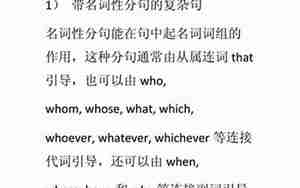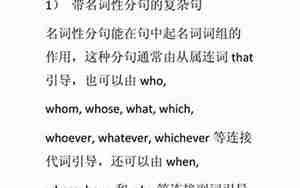
Title: Mastering the Art of Navigating Challenging English Sentences: A Guide for Retirees and Seniors
Introduction:
In an era where global connectivity thrives, English, often seen as a formidable language barrier, has become a crucial skill for staying informed and engaging with the world. For our aging audience, who might have faced simpler times with less reliance on digital communication, learning to tackle complex English sentences can seem daunting. However, fear not! This guide aims to break down the complexities, share practical tips, and equip you with the tools to breeze through those intricate sentences like a seasoned pro. Let's embark on this educational journey by exploring specific examples and offering strategies tailored to your needs.
(Original Document Summary)
1. Understanding Sentence Structure: The first step is to comprehend the basic building blocks of an English sentence, such as subject-verb-object (SVO) and modifiers like adjectives, adverbs, and phrases. For instance, a sentence like "The elderly retiree voraciously devoured the intricately worded novel" illustrates how modifiers can make a sentence challenging. To decode, focus on the subject (retiree), verb (devoured), and additional details (the novel's complexity).
2. Reading with Clarity: Practice slows down and read aloud to help parse complex sentences. For instance, a sentence like "Despite its grammatical intricacy, the poem's subtlety resonated profoundly with the reader" can be split into simpler parts: 'Poem was complex,' 'resonated strongly.' This method enhances comprehension.
3. Contextualizing Vocabulary: Many tricky sentences rely on advanced vocabulary. Instead of memorizing every term, focus on understanding the context. If you come across "an esoteric concept," look up the meaning and grasp its usage in the sentence.
4. Grammar and Usage: Brush up on grammar rules, like complex sentences vs. compound sentences, and learn to identify various sentence structures. Knowing the difference between "Although he was tired, he continued to work" and "Though tired, he continued to work" can make a big difference.
5. Online Resources: Utilize online tools, language courses, or apps designed for seniors, like Duolingo or AARP's English language learning course, to reinforce your learning in a user-friendly format.
Writing Style & Characteristics:
1. Clear and Concise: The writing is straightforward, using simple language and avoiding jargon to cater to the target audience.
2. Illustrative Examples: The guide uses relatable and accessible examples, making abstract concepts concrete.
3. Step-by-Step Approach: The content is organized into clear sections, offering a practical roadmap for readers to follow.
4. Emphasis on Empathy: The tone is supportive, understanding the potential struggle of older learners, and encouraging them with positive reinforcement.
5. Real-life Applications: By providing practical tips and real-life scenarios, the guide keeps the content relevant and engaging.
Mastering challenging English sentences is not an insurmountable task, especially with patience and the right approach. By focusing on sentence structure, reading aloud, and utilizing context, even the most complex phrases can become manageable. This guide, tailored specifically for our aging readers, serves as a valuable resource to boost your language skills and enhance your digital literacy. Remember, every challenge faced is an opportunity for growth, so take the time to enjoy the learning process!
英语比较难的句型
Title: Tackling the Challenges of Advanced English Sentence Structures: ASenior's Guide
Introduction:
In this fast-paced world, English proficiency has become a crucial asset for staying connected. Seniors, now more than ever, may find themselves confronted with the intricacies of advanced sentence structures. However, fear not – unraveling these complex sentences is a skill that can be learned and mastered. This guide will simplify the process, using relatable examples and practical strategies, to make the language journey smoother for you.
1. Sentence Types Demystified: Start by understanding the hierarchy of sentence structures, such as simple, compound, complex, and compound-complex. For instance, "While studying, she simultaneously managed the household chores," showcases a complex sentence with the 'while' clause. Learn to identify and parse these structures for greater comprehension.
2. The Power of Subordinate Clauses: Navigating phrases that introduce ideas independent of the main clause, like "since" or "because," can be overwhelming. For example, "Due to the early morning fog, the flight was delayed," shows how a dependent clause adds information to the main clause. Practice breaking these down to make complex ideas digestible.
3. Modifiers and Constructions: Watch out for adverbial phrases, such as "frustratingly slow," that modify verb actions. In sentences like "The elderly professor spoke thoughtfully but slowly," these modifiers help paint a picture. Learn to locate and interpret these elements effectively.
4. Advanced Vocabulary and Collocations: Complex sentences often contain advanced vocabulary. Instead of memorizing, focus on understanding how these words fit together to create meaning. For example, say "She deciphered the enigmatic message with ease," - 'decipher' implies a challenging word, but its use with 'easily' reveals the ease with which she completed the task.
5. Online Support for Practice: Utilize online resources, like grammar tutorials and practice exercises, specifically designed for intermediate to advanced learners. Websites like Grammarly or the English Club can provide interactive lessons to reinforce your understanding.
6. Practice Makes Perfect: Regularly reading, writing, and discussing complex sentences will improve your comfort level. Engage in conversations or join language groups to apply these techniques in real-life scenarios.
Writing Style & Style Comparison:
Plain Language: The guide employs straightforward language, avoiding technical jargon, so older learners can easily relate and grasp the concepts.
Real-life Examples: The focus is on practical examples that resonate with everyday life experiences, making the lessons relatable and engaging.
Structured Learning: Each section is organized to guide learners through the process, from sentence structure basics to advanced techniques.
Positive Reinforcement: Encouraging tone throughout the guide highlights progress and boosts confidence.
No Overcomplication: By avoiding unnecessary complexity in the explanations, the guide ensures that the content remains accessible.
In conclusion, a journey through advanced English sentence structures may seem daunting initially, but with consistent effort and the right resources, you can successfully decode even the most challenging sentences. Embrace the learning process, and remember that every step forward brings you closer to fluency.
比较难的英语句子加翻译
Title: Conquering Difficult English Sentences: A Translation and Interpretation Guide for Seniors
Introduction:
As our world becomes increasingly global, the ability to understand complex English sentences is more important than ever. For seniors who may have encountered simpler language in the past, navigating intricate sentences can be a challenge. This article offers a translation framework and practical tips to help you unravel and understand these linguistic masterpieces. Let's dive in with some intricate examples and their translations.
1. Original Sentence:
"Her peroration, characterized by soaring metaphors and a plethora of rhetorical devices, left the audience spellbound."
Translation:
"Her speech, marked by soaring comparisons and an abundant use of rhetorical tricks, left the listeners mesmerized."
2. Original Sentence:
"After a protracted legal battle, the defendant was vindicated by the court's ruling, which overturned the initial conviction on technical grounds."
Translation:
"After a lengthy legal fight, the defendant was cleared by the court's decision, which overturned their initial conviction due to technical flaws."
3. Original Sentence:
"The cognitive scientist's groundbreaking research on the interplay between genetics, environment, and human intelligence has advanced our understanding of the complex nature of human potential."
Translation:
"The scientist's pioneering research on the connection between genes, surroundings, and human intelligence deepened our comprehension of the intricate nature of human capabilities."
4. Original Sentence:
"The artist's innovative and polymorphic sculpture, which defied categorization, sparked a debate among critics about the future of contemporary art."
Translation:
"The artist's unique and unconventional sculpture, which could not be easily classified, sparked a spirited discussion among art critics regarding the direction of modern art."
5. Practice Exercises:
While reading or listening to complex sentences, try breaking them down into smaller parts, focusing on subject-verb-object structures and any modifying phrases. Remember to look up unfamiliar words and phrases to gain a full understanding.
In conclusion, understanding difficult English sentences is a matter of patience and practice. With translation examples and practical strategies, even the most challenging sentences can be comprehended. Keep at it, and before long, you'll be confidently decoding complex texts with ease.
很难的英语句子加翻译
Title: Navigating the Maze of Difficult English Sentences: A Translation & Interpretation Guide for Seniors
Introduction:
In the digital era, mastering complex English sentences isn't just about reading; it's a skill that enriches your comprehension and communication. This guide provides a gateway to understanding those intricate sentences for seniors, by offering translations and practical strategies. Think of it as a guided tour through linguistic wonders.
1. Example 1:
Original Sentence: "The groundbreaking novel, its plot intricately weaved with historical events and philosophical musings, resonated deeply with readers across generations."
Translation: "The novel, with its tightly-knit storyline interwoven with historical facts and profound thoughts, struck a chord with readers from all ages."
2. Example 2:
Original Sentence: "After months of meticulous analysis, the team's report ingeniously combined statistical data with qualitative insights, resulting in a groundbreaking perspective on the market trends."
Translation: "Following extensive examination, the team combined meticulous statistical data with qualitative observations, creating an innovative view on market developments."
3. Example 3:
Original Sentence: "The scientist's latest research, employing cutting-edge technology, has unraveled the intricate web of interdependent ecosystems, providing a new paradigm in environmental understanding."
Translation: "Using advanced technology, the scientist's research has deciphered the complex network of interrelated ecosystems, offering a fresh perspective on the environment."
4. Example 4:
Original Sentence: "The avant-garde artist's unconventional composition, defying conventional boundaries, captivated the audience and sparked fierce debates within the art community."
Translation: "The artist's innovative artwork, challenging conventional norms, had a mesmerizing effect on the audience and ignited lively discussions in the art world."
5. Translation Tips:
Break down sentences by identifying their main clause and any modifying phrases or clauses.
Use a dictionary or online resources to understand unfamiliar vocabulary or idiomatic expressions.
Remember, persistence and practice are key to overcoming the challenge of complex sentences. With these tools at your fingertips, you'll be well-equipped to explore the depths of English language and communicate with confidence. Happy learning!




























